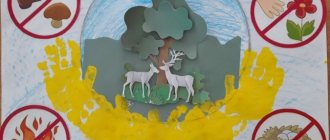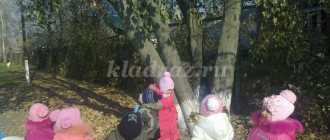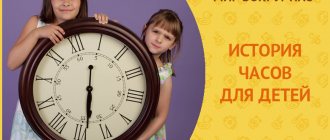MAGAZINE Preschooler.RF
Pavlova Luiza Nikolaevna teacher MBDOU Yanshihovo-Norvashi kindergarten Chuvash Republic, Yantikovsky district, Yanshikhovo-Norvashi villageTopic: “Water Sorceress” (experiments with water for older children) Purpose: - Develop interest in natural and weather conditions. To introduce and show the form in which water exists in nature, with the various phenomena of rain, dew, snow, frost, steam, ice and the state of water in the environment; To introduce the different properties of water. Excursion to nature in the summer. "Where is the water?" (in a pond, on a stream and spring, in a well). -Where do we get water from at home and in kindergarten? (children's answers) Conversation about water. Experiment No. 1. Taste of water.
Goal: Is there potable water everywhere? (No) -What does water taste like? Spring water sample. A sample of water taken from the tap in the group. Well water sample. Comparison of the taste of water. CONCLUSION: spring water is the healthiest, the purest, it comes from the depths of the earth. Where else does water exist?
Experiment No. 2. "Warm water"
Objective: Find out by comparing water from different places. Which place has the warmest water? Conclusion: Spring water and well water are the coldest. The warmest water is from the river, because it warms up in the sun. Experiment No. 3. “Dew” Purpose: Where did the dew come from? While exercising on the site, our feet got wet and we learned that dew falls in the morning. We noticed dew on the grass flower beds. It appears to fall out when wet and is able to moisturize nature. Experiment No. 3 Water in vegetables and fruits"
A teacher and children squeeze the juice of tomatoes and tangerines. All children see juice flowing out of them. Conclusion: there is water (in vegetables, fruits). -Why do people need water? (children's answers). Water has a wonderful property; it can dissolve various substances. Once you eat a pie, the water dissolves the pie into small particles and the blood distributes the nutrients throughout the body, to every cell. Water is a real magician. She knows how to transform and change. Experiment No. 4 “Colorless water” Take a glass of water and add salt to it, see what happened? (salt has dissolved). Did the salt change the color of the water? ( No). We taste the water - it is salty. Conclusion: When salt is added, water can remain the same clear, but the taste will change. Experiment No. 4 “Where did the water disappear? “We pour river water into a bottle, close the lid, put it in the sun and leave it for a month, hiding it from strangers. After a month we come back and find out how it decreased. After all, we left a full bottle, but here it is incomplete. Conclusion: Water evaporates in the sun.
Experiment No. 5. "Cold water"
Purpose: Why is the water cold? In late autumn we return to the river. For some reason the water in it became cold. Conclusion: We find out that the state of water in nature changes due to cooling weather conditions.
Experiment No. 6. “Icy water” Goal: “Where did the piece of ice come from?” We return to the river in the cold autumn, when the ground around us is frozen and we see that the river is covered with a thin piece of ice on top. We take a piece of ice from the river and determine what it is? It turns out that the water froze in the river and turned into ice. A piece of ice is like glass and can break very quickly. Conclusion: Water can change its previous shape.
Experiment No. 7. "Ice rink"
Goal: With the onset of winter, we come to the hill with a sled. The former river and the ground are covered with snow. We check, will the ice support us if we step on it? The children and I clean the snow on the ice and check that the ice has become strong. There is nothing to be afraid of, he will withstand us. It is smooth, slippery, you can even slide on ice. Game "Sliding on Ice"
Conclusion: The ice is compacted, it is smooth, cold, hard and slippery.
Experiment No. 8. “Patterns on the window” Purpose: How are patterns on windows created? We spent a long time wondering with preschoolers how patterns appear on windows? They began to observe and found out: steam rises from the kitchen, collides with warm air coming out of the window and, as a result, the steam sticks to the window and from this patterns are created on the windows. Conclusion: The meeting of warm air with cold air can create patterns on windows. Experiment No. 9. “Trees in frost” Purpose: “Where does frost come from?” On a walk with preschoolers, we noticed how the trees were covered with frost. After all, before there was no thin layer of snow cover attached to the tree branches. To clarify this phenomenon, we turned to biology teacher V.V. Lukina for help. She explained to us that the warming of the weather and sudden cold snaps cause frost. Conclusion: Warming weather and sudden cold snaps cause frost.
| Next > |
Experiment with water of different temperatures
For the next experiment you will need four glass beakers and paints. This water experiment for preschoolers shows the properties of water at different temperatures.
- You need to pour cold water into two glasses, warm water into the other two.
- You can add yellow to cold water, and black to warm water.
- Place one of the glasses with yellow cold water on a plate. Cover the glass with warm water with a plastic card and turn it upside down and place it in this form on a glass with cool water, that is, the glasses with different water will be mirrored, with a plastic card between them.
- Then you need to very carefully pull out the card, while making sure that the glasses do not move, and hold them in their original position.
Here you can see that cold and hot water have not mixed, this happens because heat tends upward and cold tends downward.
There are still two glasses left, you can try to do this experiment in reverse - put hot water down and cold water up. In this case, the water will mix.
Rainbow water
To make experiments with water more entertaining for preschoolers, it is better to paint the water in different colors using ordinary watercolor paints. For the next experiment you need paints, granulated sugar, a glass glass, water, a syringe, and four small glass cups.
- There is no need to pour sugar into the first glass, half a teaspoon of sugar should be thrown into the second, a full teaspoon of sugar into the third, and one and a half teaspoons into the fourth.
- Now you need to add water to each glass and stir the sugar.
- For the first, take red and mix it, for the second - green, add black to the third, and add yellow to the fourth.
- Then you need to take a syringe and draw water from the first glass of red water without sugar. Pour the contents of the syringe into an empty prepared glass.
- Next, using a syringe, draw green water from the second glass, in which half a teaspoon of sugar is dissolved; the syringe must be lowered to the bottom of the glass with the red water collected and slowly release the water with green paint.
- Now the same procedure should be carried out with the third glass, where the water is black and contains one spoonful of sugar. You need to release it from the syringe in the same way as the previous step.
- And there was a fourth glass left. Everything is the same - water is drawn from it using a syringe and released to the bottom of the glass.
At the end of the experiment, you can notice how the glass turned out to be “rainbow water”; all the colored layers of water did not mix, but were located one after the other, having clear boundaries. The more sugar added, the greater the density of the water, which explains the lack of mixing. The more colors you use, the more colorful and visual the experience will be.
Bringing to a boil
Take a glass of water and place it in the microwave until the water almost boils.
Attention! You should only remove it using an oven mitt; the glass will be hot.
Immediately place a pencil into a glass of boiling water, and you will see how amazingly the water boils until air bubbles form upon contact with a foreign object. In addition to a pencil, you can place anything in the water: it can be a toy dinosaur or an ordinary spoon.
The fact is that in a microwave oven, steam bubbles cannot form in a transparent glass of water; there is simply no room for them. Why? The temperature of a glass container, in this case a glass, which is transparent to microwave microwaves, is much lower than the temperature of the water in it. Therefore, if there are no bubbles in the water, then it can neither cool nor heat up.
But if you place an object there, it heats up to the temperature of the water, while allowing it to cool, due to the thermal conductivity of the water, so it begins to boil. Steam is released.
Such experiments for preschoolers should be carried out with special caution.
Ice Formation
In this experiment you will need a 0.5 liter plastic bottle with a cap containing distilled still water.
- The bottle should be placed in the freezer at -25 degrees for 2 hours.
- After this, take out the bottle and hit the bottom on the table - the water will begin to freeze right before your eyes.
The whole process can be explained by the fact that there are no crystallization centers in distilled water, and moreover, it is at rest in the freezer. But as soon as you shake it sharply, air bubbles appear in the water, which provoke the crystallization process, and the water begins to harden and turn into ice.
We suggest you conduct these simple but interesting experiments for preschoolers at home or in kindergarten. We are sure that they will interest not only children, but also adults.
Matches experiment
For the first experiment with water for preschoolers, you will need a glass glass, watercolor paints, a deep plate, and plasticine. An experiment using water will clearly show how air pressure changes during combustion.
- You need to pour water into a glass, add any color of paint to it with a brush and stir, this is necessary for the clarity of the experiment.
- Next, put a piece of plasticine at the bottom of an empty plate, into which insert two matches.
- Pour colored water from a glass into a plate.
- Under adult supervision, you need to light these matches and cover them with an empty, dry glass.
As a result of a simple experiment, the matches go out, and the colored water begins to rise up. This happens because during combustion the air pressure in the glass becomes less than outside.
experimentation lesson “Properties of Water” for the older group (5-6 years old)
Principles of preschool education (FSES DO):
building educational activities based on the individual characteristics of each child, in which the child himself becomes active in choosing the content of his education, becomes the subject of education;
assistance and cooperation of children and adults, recognition of the child as a full participant (subject) of educational relations;
supporting children's initiative in various activities;
formation of cognitive interests and cognitive actions of the child in various types of activities;
age adequacy of preschool education.
Principles of education:
formation of a personal style of relationships with peers and teachers, creation of a positive emotional background and an atmosphere of emotional uplift, education through interaction.
Principles of training:
The principle stimulates the experimental activity of a preschooler; the principle of freedom and independence; principle of activity, principle of consistency.
Education methods:
conversation, encouragement.
Teaching methods:
conversation, demonstration, showing, experimenting, explaining.
Speech development methods:
Verbal (conversation), practical (exercise)
Educational means:
visual (illustration), display
Learning Tool:
instructions (experiment sequence diagram)
Equipment:
package, letter, presentation, disposable cups and spoons, jars for drawing, drinking water, tap water, essential oil, dye, brushes, cocktail straws, educational game, pictures (river, lake), several transparent vessels of different shapes.
List of used literature:
— Federal state educational standard for preschool education Order of the Ministry of Education and Science of Russia dated October 17, 2013 No. 1155 “On approval of the federal state educational standard for preschool education”
From birth to school: an exemplary general education program for preschool education/N. E. Veraksa, T.S. Komarova, M.A. Vasiliev "MOSAIKA-SYNTHEZ PUBLISHING HOUSE", Moscow 2022. -340 pp., Federal State Educational Standards of Education
Resolution of the Chief State Sanitary Doctor of the Russian Federation dated May 15, 2013 N 26 “On approval of SanPiN 2.4.1.3049-13 “Sanitary and epidemiological requirements for the design, content and organization of the operating mode of preschool educational organizations.”
Progress of educational activities:
| Sequence of activities | Methods | Contents of the activity Teacher | Children's activities | Planned result |
| 1. Motivational stage. Task: Gather children's attention and motivate them for upcoming activities | Emotional stimulation Conversation Demonstration Illustrations Game situation Promotion | The teacher attracts the attention of children, emotionally includes them in action, and involves them in listening. — Guys, this morning I found a package at the door of our group. But I didn’t open it without you. I wonder what is in this package? Do you want to know? Sample children's answer: Yes -Stand in a semicircle so that everyone can see, and I will open the package. -Guys, look what’s here, it’s the same letter, how could we not notice it right away? Do you want to know what it says and who it’s from? Sample children's answer: Yes "Dear Guys! We are fixists and we invite you to our laboratory to study water. We'll be glad to see you. Everything you need for the experience is in this package.” -How interesting, so guys, let’s go to the laboratory and see the fixers? Sample children's answer: Yes The teacher listens to the children's answers. | Enter into dialogue with the teacher, share impressions, show interest in research activities | Children are motivated and interested curiosity, willingly communicate with the teacher, take an internal position towards the upcoming activities. |




